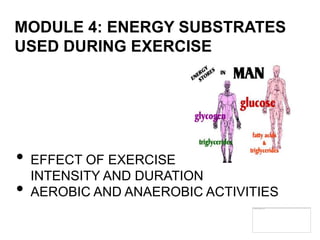
Module 4 mcc sports nutrition credit course - energy substrates used during exercise
- 1. MODULE 4: ENERGY SUBSTRATES USED DURING EXERCISE • EFFECT OF EXERCISE INTENSITY AND DURATION • AEROBIC AND ANAEROBIC ACTIVITIES
- 2. ENERGY SYSTEMS ANAEROBIC
- 3. PHOSPAGEN / ATP-CP SYSTEM • ATP (Adenosine Triphosphate) is stored in all cells, particularly muscles • It is free energy, body makes it available for immediate use, needs recovery time to restore the storage • Great for short and quick activities, because it only last for about 5 seconds. • Activities like-- 10 metre sprints, diving, spiking and throwing the shot. • When ATP is used it breaks down into ADP. ADP then can combine with phosphocreatine (PC) to make more ATP, but only for a short period of time around 5-20 seconds. • These two systems combine for activities like 200m sprints and sports where short intermittent burst of activity are required— for example, basketball, hockey and rugby.
- 4. Notes ATP (adenosine triphosphate) is the primary molecule of energy for human movement. At rest we have a small store of ATP, perhaps a few seconds of intense performance worth. This is replenished by another important molecule, phosphocreatine or creatine phosphate (PCr). Energy from this system is supplied very quickly but lasts less than 10 seconds before it needs to be replenished with res
- 5. LACTIC(LA) SYSTEM • This system begins when phosphocreatine stores are deplete • The body requires another ingredient-- muscle glycogen (glucose) to be added to continue. • Lactic acid (or lactate) comes from the breakdown of the glucose released from the muscles. • Outcome- Positive Hydrogen ions accumulate in the muscle and cause it to fatigue. • Sports that do repeat sprinting or high energy activities, such as ice hockey, sprint cycling, 100m swim, lacrosse, soccer, up to the 400 metres in track.
- 6. Notes: Beyond the energy supply of the PCr system, and with continued high-intensity activity, the lactic acid system takes over and produces another supply of ATP, limited by the rate of oxygen availability, for up to about 90 seconds depending on intensity and lactate tolerance. This system will dominate in a 400 metre runner or 100 metre swimmer for example, although most activities longer than about 10 seconds use a mix of energy systems. Glucose stored in muscle as glycogen is the main source of energy substrate for this system. Performance can be limited by inadequate storage of muscle glucose, or inhibition of the rate at which it is made available. These two systems, alactic and lactic, supply fast energy.
- 7. OXIDATIVE SYSTEM • Using oxygen to fuel the breakdown of carbohydrates first, free fatty acids second and if the exercise continues long enough -protein. • The aerobic system is more for moderate or low intensity work, but of longer duration.
- 8. Notes Oxygen supply maintains the aerobic system more or less perpetually as long as a fuel source is available, energy again being ultimately provided as ATP. The aerobic system uses blood glucose, muscle glycogen, blood fats, muscle triglycerides and even ketones (breakdown of fats) — and proteins in certain circumstances. Needless to say, this is the dominant energy system of longer exercise duration and day-to- day living. Understand, though, that a mix of fuel sources and energy systems, including anaerobic glycolysis (lactic acid system) will occur even in a marathon or long bike race, in, say, acceleration up a hill or a sprint finish.
- 10. Effect of exercise intensity and duration - CARBOHYDRATE
- 11. Carbohydrate: High Power Fuel • Fast ATP production • Carbohydrate is the only energy substrate that can produce ATP anaerobically • More calories (kcal) provided per liter (L) of oxygen consumed (5.01 kcal/L) • Primary use by fast twitch muscle fibers (recruited during high intensity exercise)
- 12. Effect of exercise intensity and duration - FATS
- 13. Fat: Low Power Fuel • Slow ATP production -- Fat can only produce ATP via aerobic metabolism • Fewer calories (kcal) provided per liter (L) of oxygen consumed (4.65 kcal/L) • Primary use by slow twitch muscle fibers (recruited during low-moderate intensity exercise)
- 16. ACTIVITY
- 18. Aerobic and anaerobic activities. AEROBIC EXERCISE ANAEROBIC EXERCISE Using the same large muscle group, Anaerobic activity is short in rhythmically, for a period of 15 to duration and high in intensity. 20 minutes or longer while maintaining 60-80% of your maximum heart rate Walking, biking, jogging, Racquetball, downhill skiing, swimming, aerobic classes and weight lifting, sprinting, softball, cross-country skiing soccer and football.
- 19. Examples of mild to moderate aerobic activities: • Take a short walk around the block • Rake leaves • Play actively with the kids • Walk up the stairs instead of taking the elevator • Mow the lawn • Take an activity break--get up and stretch or walk around • Park your car a little farther away from your destination
- 20. Examples of higher intensity aerobic activities: • Brisk walking, Jogging, Bicycling, Swimming • Aerobic dancing • Racket sports, Rowing • Ice or roller-skating • Cross-country or downhill skiing • Using aerobic equipment (i.e., treadmill, stationary bike)
- 21. ACTIVITY
